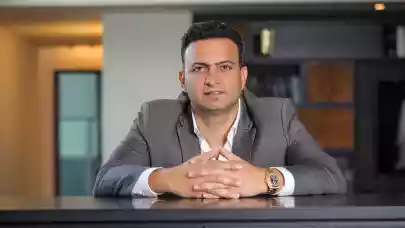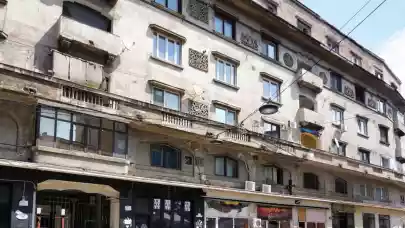
Yitzhak Hagag, Co-Founder and Shareholder, Hagag Development Europe, spoke with Property Forum about the increasing demand for the company’s boutique office buildings in central Bucharest and the strong sales book for its residential developments in the city. The company has a development budget totalling €195 million.
This interview was first published in Property Forum’s annual listing of "The 50 most influential people on Romania’s real estate market”.
What were Hagag Development Europe’s development highlights during 2023 and what are your plans for this year?
A lot has happened during 2023, starting with the inauguration of H Private Arghezi, and continuing with the kick-off of the construction works for H Știrbei Palace. Altogether, we have been working on five ongoing projects and some new acquisitions and made significant progress with the development of our large-scale residential project in Pipera and its commercial component. Therefore, we feel confident that a lot more will happen this year.
We are focused on completing, by the end of Q3, the consolidation and refurbishment of the Palace’s building, and eager to launch a new residential project that we have been working on for a while now. Likewise, we estimate that the delivery of the commercial component of H Pipera Lake will happen by the end of 2024, and we are working on obtaining the building permit that will allow us to break ground on the 12 remaining residential buildings in H Pipera Lake which we plan to develop concurrently.
What is the value of your development pipeline in Romania and which segments will attract the biggest share of investments?
For ongoing and pipeline projects alone, we are talking about a net development budget that exceeds €195 million. The biggest share will go towards residential that will absorb about 68%, with the rest going to retail and hospitality. Compared to last year’s forecast, we have now adjusted our global development costs based on the current inflation rates, fiscal changes, increased costs across all industry sectors and workforce costs. And with the PUG and PUZs frozen for so long, we find ourselves stuck in a loop that pushes us to reassess our development timelines and investment budgets.
How did your office portfolio perform last year and are you seeing any trends in the leasing segment this year?
Considering the change of paradigm in the office market, with tenants focusing more on smaller surface areas, relocations, boutique buildings and central locations, there was absolutely no reason for our office portfolio not to perform well. And with H Victoriei 109 fully leased, the star product was, without doubt, H Private Arghezi – which witnessed exceptional leasing dynamics and was registering, on December 31st, an occupancy rate of 82%. Furthermore, we ended the year with open discussions for the lease of about 3,500 sqm of office and retail space in H Tudor Arghezi 21, and we have recently concluded the lease of approximately 1,500 sqm.
The remaining 2,000 sqm are now the subject of advanced discussions and we anticipate a positive outcome. As far as market trends are concerned, we believe the demand for smaller surfaces ranging between 150-400 sqm will continue as the dominant tendency, alongside tenants’ appetite for relocating to well-connected boutique buildings in central areas. The flight to quality is also very important, and we see many start-ups and companies active in the energy field looking to upgrade from class B to class A buildings, and from shared spaces to private offices.
We see the local subsidiaries of international companies looking to optimise costs due to the “work from home” rush, thus leasing one or more serviced offices to accommodate their teams, but we also see an increased interest, coming from medium and large-sized companies, for turnkey conventional spaces. Even if this means engaging in a long-term contract with a higher price per sqm. Among landlords, refurbishing and upgrading existing assets seems to be the main trend.
How did the Bucharest-based market receive your private office space offering? Are you looking to expand this model?
Judging by the fact that only four months after inauguration we have expanded H Private Arghezi with an additional floor (420 sqm) due to high demand, the impressive occupancy rate (today 87%), and the tremendous volume of requests that we are constantly receiving, we are more than positive that our private office product was warmly welcomed. And yes, the know-how we accumulated, together with the positive feedback we are regularly collecting from the over 30 active tenants in H Private Arghezi, encourages us to consider the opening of a second location. Especially if we take into account that the serviced offices segment has seen tremendous growth over the past 12 months, and us having already delivered a prime product, with elite services and facilities, obviously we have a competitive advantage in this niche.
What is your outlook for demand in the residential segment and what progress are you recording on sales in your projects?
With a 30% drop in the total residential supply in Bucharest in Q4 2023 compared to Q4 2022, a 16% drop in new supply for the same period, and a 40% increase in demand for new dwellings, if we were betting right now, residential would be by far the winning hand.
Looking ahead to 2025-2027, we see an extremely limited pipeline of new dwellings. And though we are currently out of stock, our pipeline comprises approximately 1,200 residential units to be delivered over the following four years and ambitious future development plans. All of these in what looks to be an excellent market context. Moreover, we have close to 200 units in H Pipera Lake booked in pre-sale, and an impressive waiting list for our high-end projects H Eliade 9 and H Primaverii 1. Therefore we are quite optimistic that our future launches will be, too, widely embraced by the market.
How attractive is Romania for new real estate investments compared to other countries in the region? What are some of the strong points of the local market?
Leaving behind all shortcomings and frustrations generated by the fiscal instability, the PUG and PUZs situation in Bucharest, and the bureaucracy that slows down the pace of real estate developments, the Romanian real estate market offers something quite unique. Something that visionary investor-developers like us can only find in emerging markets: demand volumes that exceed the offer, historical buildings waiting to be repurposed, and an exclusive opportunity to innovate and to redefine industry standards.



